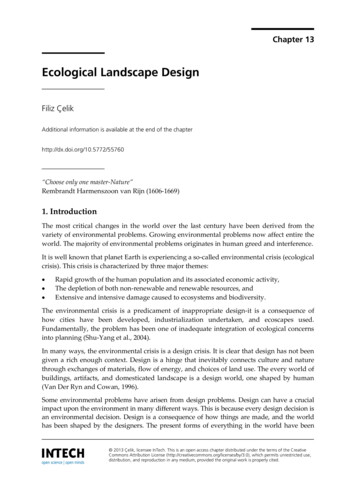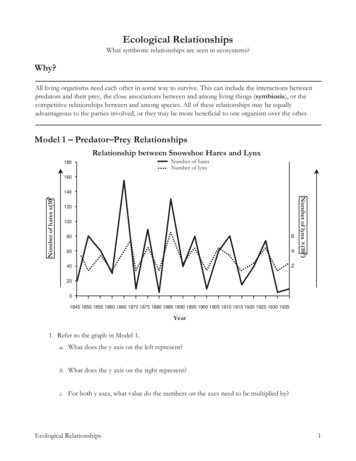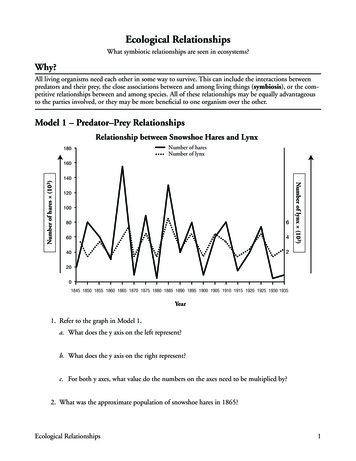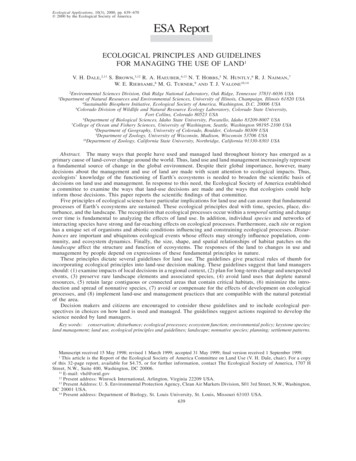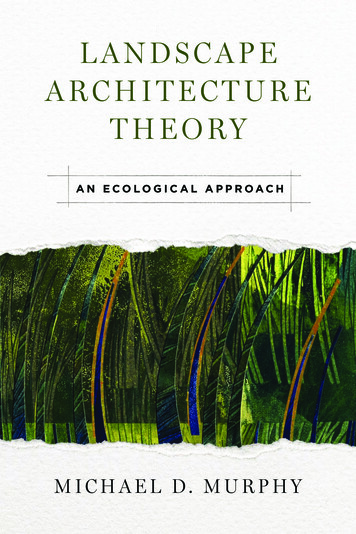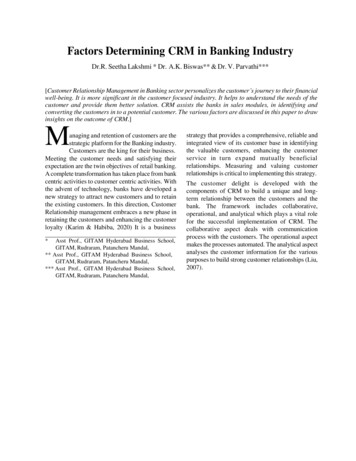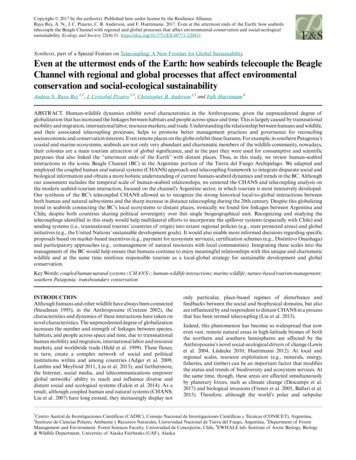
Transcription
Chapter 18Ecological and Social Factors Determiningthe Diversity of Birds in Residential Yardsand GardensMark A. Goddard, Karen Ikin, and Susannah B. LermanI value my garden more for being full of blackbirds than ofcherries, and very frankly give them fruit for their songs.(Joseph Addison, English essayist,poet, and politician, 1672–1719)Abstract Residential landscapes with private yards and gardens are a major landcover in many cities, represent a considerable opportunity for bird conservation andenhance human experiences with wildlife. The number of studies of birds inresidential landscapes is increasing worldwide, but a global-scale perspective onthis research is lacking. Here we review the research conducted on birds inresidential settings to explore how birds respond to this novel habitat and howprivate gardens can be designed and managed to enhance their value for birdpopulations and for human well-being. We examine the key ecological and socialdrivers that influence birds and draw particular attention to the importance of scale,the role of bird feeding, the predation risk from cats and the relationship betweennative vegetation and bird diversity. The success of bird conservation initiatives inresidential landscapes hinges on collaboration between a range of stakeholders, andwe conclude the chapter by making recommendations for urban planners andevaluating policy tools for incentivising householders and communities to conservebirds in their neighbourhoods.M.A. Goddard (*)School of Civil Engineering and Geosciences, Newcastle University, Newcastle upon Tyne,UKe-mail: mark.goddard@newcastle.ac.ukK. IkinFenner School of Environment and Society, The Australian National University, Canberra,AustraliaS.B. LermanUSDA Forest Service Northern Research Station, Amherst, MA, USADepartment of Environmental Conservation, University of Massachusetts, Amherst, MA, USA Springer International Publishing AG 2017E. Murgui, M. Hedblom (eds.), Ecology and Conservation of Birds in UrbanEnvironments, DOI 10.1007/978-3-319-43314-1 18371
372M.A. Goddard et al.Keywords Private gardens Socio-ecology Supplementary feeding Catpredation Urban planning18.1The Garden ResourceAlthough we may not all articulate it as eloquently as Addison, people have longsought to cater for birds in their gardens. Indeed, of all the places that we encounterbirds in cities, it is in our private gardens and yards (hereafter gardens) that theseinteractions are often most meaningful. It is here that many of us spend vastamounts of time and money to interact with birds by providing vegetation, food,water or nest sites. Ultimately, whether birds or people (or both) benefit from theseactivities remains an active area of research, but when this resource provision isscaled up across neighbourhoods, it becomes clear that the collective impact ofprivate gardens in our towns and cities is substantial (Goddard et al. 2010; Lermanand Warren 2011; Belaire et al. 2014). This is especially true in many developedcountries where private gardens are often a major urban land cover. For instance, anestimated 87 % of UK householders have domestic gardens (Davies et al. 2009).Collectively, these gardens cover approximately 25 % of the land area of UK cities,which equates to 35–47 % of the total urban green space (Loram et al. 2007).Elsewhere, gardens are even more plentiful; in Dunedin, New Zealand, the vegetated garden area comprises over one third of the total urban area (Mathieuet al. 2007). Although they may differ in their management and form, gardenscan also be important components of cities in the global south, e.g. residentialgardens in Chile (Reyes-Paecke and Meza 2012), urban home gardens in Brazil(Akinnifesi et al. 2010) and urban ‘patios’ in Nicaragua (Gonzalez-Garcia and Sal2008), and their importance is likely to increase further as global urbanisationcontinues at a rapid pace (Fragkias et al. 2013).In addition to the extent of gardens across our cities, the management of theseresidential habitats plays a significant role in their contribution to bird conservation.Over three quarters of US householders participate in some form of gardening(Clayton 2007) and, in 2013, spent an estimated 34.9 billion on gardening suppliesand activities (National Gardening Survey 2014). Moreover, 13.4 million Americans maintain vegetation or natural areas specifically for wildlife (US Government2011). Birds are often the main target of such wildlife-friendly management, asevidenced by the popularity of bird feeding and nest box provision compared toother wildlife gardening activities (Davies et al. 2009; Goddard et al. 2013).The upshot of the large number of gardens across cities and their potential birdfriendly management is that private gardens can have considerable ‘direct’ and‘indirect’ value for bird conservation (Cannon 1999). On the one hand, residentiallandscapes within cities provide a direct habitat resource for birds. Early investigations in the USA revealed that residential areas were comparable in bird diversityto the natural habitats on which they were developed (Guthrie 1974; Emlen 1974).Residential developments in the UK have also been shown to have greater valuethan farmland for thrushes (Turdus spp.) as agricultural intensification depletes the
18Ecological and Social Factors Determining the Diversity of Birds in. . .373quality of rural habitats (Mason 2000). Urban-rural gradient studies tend to showthat dense urban centres have a homogenising effect on bird communities (Clergeauet al. 2006), but intermediate levels of urban development, characterised by residential gardens, are often associated with peaks in bird richness or abundance,where so-called urban adapter species thrive and mix with a few ‘urban avoiders’and ‘urban exploiters’ (Blair 1996; Sewell and Catterall 1998; Blair 2004; Trataloset al. 2007). Although residential landscapes may not support many habitat specialists, they can be important for species of conservation concern, such as housesparrows (Passer domesticus) and starlings (Sturnus vulgaris) that are declining inthe UK (Fuller et al. 2009). Moreover, gardens certainly contribute to the conservation of common birds which appear to be declining more rapidly than rarerspecies in Europe (Inger et al. 2015).In parallel with their direct significance for birds, gardens also have indirectconservation value by increasing people’s engagement with birds and fostering acommitment to nature conservation more widely (Cannon 1999). When householders participate in citizen science bird monitoring programmes, it often leads toimportant data for fundamental scientific research, such as how climate changeaffects bird communities (Princé and Zuckerberg 2015). Participation alsoempowers the householder by providing tangible benefits for people, such asimproved sense of place (Evans et al. 2005). Evidence is also growing thatinteracting with wildlife is beneficial to human health. For instance, when controlling for variation in demographic characteristics, the species richness and abundance of birds in southeastern Australian neighbourhoods was positively related tohuman well-being (Luck et al. 2011).In the rest of this chapter, we develop the conceptual framework of Goddardet al. (2010) by viewing gardens as socioecological constructs that can influencebirds at multiple spatial scales (Fig. 18.1). Our geographic scope is global, but wenecessarily focus on the UK, the USA and Australasia as there is a research biastowards these countries. In Sect. 18.2, we discuss the ecological drivers of birddiversity at garden to landscape scales. We then explore the human dimension inSect. 18.3, highlighting garden management decisions that impact birds(i.e. landscaping, bird feeding and cat ownership) and their underlying socioeconomic drivers. In Sect. 18.4, we turn our attention to urban policy, planningand tools for incentivising and engaging householders and other stakeholders inbird conservation initiatives. We conclude in Sect. 18.5 by highlighting key knowledge gaps and research priorities. Addressing how private gardens can be betterdesigned and managed to strengthen their potential for bird conservation andhuman well-being will greatly benefit urban planning and policy.18.2Ecological Drivers of Bird DiversityEcological drivers of garden bird diversity range from the scale of an individualfeature (e.g. a tree or a shrub) through to that of an entire city (Goddard et al. 2010).These scales match different events in the life histories of birds, from the
374M.A. Goddard et al.Fig. 18.1 Ecological and social drivers of garden birds at nested spatial scales. At the householdscale (top panel), individual habitat features (e.g. trees and shrubs) and householder decisions(e.g. to provide supplementary food, to irrigate the garden and have an outdoor cat) affect theability of birds to find suitable forage and nest sites. At the neighbourhood scale (middle panel), theextent, composition and configuration of habitat in groups of adjacent gardens are dictated byvariation in socio-economic status and social norms in gardening practices. At the city scale (lowerpanel), the clustering of residential habitat with other urban green spaces reflects urban planningand green infrastructure strategies. Blue arrows represent the different life stages of garden birds atdifferent scales in the garden hierarchy, from eggs in an individual nest at the garden scale (toppanel) to nestlings in multiple gardens (middle panel) and fledglings dispersing within and beyondthe city (lower panel)consumption of a berry, to the placement of a nest for the season and the interactions of birds within a population or with birds of other species (Fig. 18.1). It isimportant to note that whilst all birds require habitat to forage, nest, shelter andinteract, what constitutes good habitat can vary substantially between bird species,
18Ecological and Social Factors Determining the Diversity of Birds in. . .375as does the scale in which an individual species uses that habitat (Hostetler andHolling 2000). For example, cactus wrens (Campylorhynchus brunneicapillus) usehabitat features at the scale of the individual property, whilst Lesser Goldfinches(Spinus psaltria) respond to habitat features at the neighbourhood scale, and Gilawoodpeckers (Melanerpes uropygialis) are influenced by features from a combination of scales (McCaffrey and Mannan 2012). The ecological drivers of gardenbird diversity, furthermore, vary with changing climatic and geographical context.Cultivated gardens with a year-round supply of leafy plants will be perceived bybirds in tropical regions much differently to their desert cousins. In this section, weaddress each scale of ecological drivers in turn and discuss their relevance fordifferent birds and for different geographic contexts.18.2.1 Garden-Scale Ecological DriversGardens are landscaped with individual vegetation and structural features, such astrees, shrubs, grasses, rocks and water features. These garden-scale features directlylink to the availability of habitat resources for birds and are important for shapingurban bird communities (Daniels and Kirkpatrick 2006; Evans et al. 2009; vanHeezik et al. 2008; Chamberlain et al. 2004; Parsons et al. 2006). Gardens,however, exhibit individual variability, whereby different styles of gardens emphasise different habitat features with ensuing effects to the bird community. Forexample, van Heezik et al. (2008) found that gardens in New Zealand with atleast 30 % open-vegetated space supported more specialist native bird species,including species that were virtually absent in gardens with minimal vegetation.Cultivated gardens can be ‘oases’ of otherwise scarce resources, for example, assources of water in dry climates (Bock et al. 2008). However, polarisation betweenintensively managed exotic vegetation and more ‘natural’ plant communities,especially in urban areas with relatively short histories, can result in decreasinghabitat resources for the native bird community (but see Gleditsch 2016). Forexample, studies from Phoenix, USA, have shown that gardens landscaped withnative desert plants contain more abundant foraging resources and have lowerforaging costs, as well as a bird community less dominated by aggressive urbanbirds and more desert bird species, than gardens landscaped with exotic plants(Lerman et al. 2012b; Lerman and Warren 2011). Similarly, in Hobart, Australia,gardens with native plants had significantly more native birds (Daniels andKirkpatrick 2006). When comparing gardens landscaped with native plants withgardens landscaped with exotic vegetation, Burghardt et al. (2009) found that thenative gardens supported a greater abundance and richness of caterpillars and,subsequently, birds, since many species rely on this food source for feedingnestlings. Native gardens were especially important for bird species of conservationconcern, supporting eight times the abundance of these species compared withexotic gardens. Interestingly, there is much less evidence for a positive associationbetween native plants and birds in the UK or Europe, where urbanisation has alonger history.
376M.A. Goddard et al.Many birds, including those sensitive to urban landscapes, benefit from vegetation structural complexity, which can be achieved by planting out garden beds withdense shrubs, allowing leaf litter to accumulate under trees, choosing tussock ormeadow grasses over lawn or leaving areas of lawn unmown. For instance, inCanberra, Australia, urban-sensitive native species were more likely to be recordedin front gardens characterised by trees, shrubs and ground covers compared withfront gardens dominated by lawns (Ikin et al. 2013b). The capacity of gardens tocontain these diverse habitat features is positively related to garden size. Smithet al. (2005), for example, found that larger gardens in the UK were more likely tohave large trees and a higher diversity and occurrence of vegetation than smallergardens. Kaoma and Shackleton (2014) likewise found that larger gardens inSouth Africa had a higher density of trees. It is concerning, therefore, that thecurrent trend in housing development is for smaller gardens that require lowmaintenance and lack diverse habitat resources (van Heezik et al. 2008; Gastonet al. 2005; van Heezik and Adams 2014).It is worth noting that the design and management of gardens can result inperverse outcomes for the bird community by leading to the overabundance of somebird species that might have negative consequences for other species. For example,in Australia, nectar-rich cultivars of native flowering shrubs are promoted as being“bird friendly” by nurseries, and people plant them to entice birds to their gardens.However, studies have shown that these flowering shrubs attract aggressiveAustralian honeyeaters that exclude smaller birds, many of which are declining inurban landscapes (Parsons et al. 2006; French et al. 2005). Further, Daviset al. (2014) showed that these shrubs also provided a year-round source of nectarwithin suburban areas compared with native forests, supporting high densities oflarge nectar-feeding parrots whose dominance then enables them to outcompeteother species for nesting resources (Davis et al. 2013).Compared with research focused on other urban green spaces, there have beenrelatively few studies of bird habitat use in gardens. These studies have hadcontrasting findings about the relative importance of local garden-scale variablescompared with those measured in the surrounding landscape. For example, Lermanand Warren (2011) found that front garden habitat, particularly the presence ofdesert trees and shrubs, was twice as important as regional landscape features forexplaining variation in the urban bird community of Phoenix, USA. In comparison,French et al. (2005) found that the abundance of nectivorous species in gardenswithin Sydney, Australia, was better predicted by the vegetation characteristics ofadjoining and more distant gardens than the vegetation characteristics of a singlegarden. In the next section, we explore the influence of neighbourhood and cityscale ecological drivers on garden birds.
18Ecological and Social Factors Determining the Diversity of Birds in. . .37718.2.2 Neighbourhood and City-Scale Ecological DriversBirds are highly mobile and most species use the landscape at multiple scales,including scales larger than an individual garden (Hostetler and Holling 2000;Hostetler and Knowles-Yanez 2003, Litteral and Shochat 2016; but see Danielsand Kirkpatrick 2016). This leads to scale mismatch, whereby the capacity ofgardens to provide habitat for birds is constrained or enhanced by the suitabilityof habitat in the surrounding landscape (Goddard et al. 2010; Warren et al. 2008;Catterall 2004). For example, Gambel’s quail (Callipepla gambelii) needs areas ofdesert vegetation larger than the average garden, but when a garden adjoinsparkland or a group of gardens are planted with desert vegetation, the cumulativeeffect could provide sufficient habitat (Hostetler and Knowles-Yanez 2003). Recentresearch has demonstrated that whilst local-scale factors may well be most important, acknowledging the contribution of landscape-scale attributes can improve ourunderstanding of birds in urban environments (Melles et al. 2003; MacGregor-Forsand Ortega-Álvarez 2011; Suarez-Rubio and Thomlinson 2009; Donnelly andMarzluff 2004).The collective attributes of neighbouring gardens represent important drivers ofgarden bird diversity. Belaire et al. (2014), for example, investigating birds withingroups of gardens in the Chicago region, USA, found that the richness of nativebirds was strongly related to the aggregated wildlife value of the gardens (e.g. thepresence of trees, plants with fruits or berries and mix of evergreen and deciduoustrees). In contrast, the vegetated area and canopy cover within the neighbourhoodand amount of green space within the wider landscape provided a weaker explanation of native bird richness within gardens. Chamberlain et al. (2004), in comparison, found that the occurrence of garden birds across the UK was stronglyinfluenced by neighbourhood attributes, such as the presence of brownfield andgreen space areas.Neighbourhood attributes influence local-scale garden characteristics andlandscape-scale habitat suitability (Catterall 2004). For example, gardens in theinner city (i.e. located in areas of high housing density) support different birdassemblages to gardens in exurban developments (Kluza et al. 2000; Germaineet al. 1998). Several studies have found higher bird diversity when residentialstreets were planted with native trees (Ikin et al. 2013b; White et al. 2005; Younget al. 2007). For example, native forest bird species richness within residentiallandscapes of Seattle, USA, was positively related to tree density in the landscape(Donnelly and Marzluff 2006). These positive relationships suggest that tree covercould be used as a surrogate measure of available bird habitat. However, caution isneeded when using tree cover as a proxy of habitat for all species. Urban-sensitivebirds in Canberra, Australia, for example, had no relationship with tree cover butinstead were related to habitat structural complexity, i.e. diversity of strata, including shrubs and ground layer (Ikin et al. 2013b). How cities are planned anddeveloped can also strongly influence the habitat values of gardens for birds (seeSect. 18.4.2).
37818.3M.A. Goddard et al.Social Drivers of Garden Bird Richnessand Abundance18.3.1 Socio-economic StatusIn recent decades, urban ecology has emerged as an important discipline thatintegrates natural and social sciences in order to understand what drives ecologicalfunctioning in and around towns and cities (Tanner et al. 2014; Grimm et al. 2008).Perhaps more so than any other urban habitat, private gardens can be seen as‘hybrid’ creations (Power 2005) or ‘socioecological constructs’ (Goddardet al. 2010) such that understanding residential landscapes demands an interdisciplinary approach (Cook et al. 2011). A central tenet of urban ecology is theassociation between human social stratification and urban biodiversity (Warrenet al. 2010), and studies of urban vegetation have consistently found that wealthierneighbourhoods support greater levels of vegetation cover or higher plant diversity(e.g. Hope et al. 2003; Martin et al. 2004; Lubbe et al. 2010; but see: MeléndezAckerman et al. 2014). There are a number of putative mechanisms for thisso-called luxury effect, but given the cost of planting trees and shrubs, economicscan certainly hinder people’s choices for adding to or replacing existing vegetationto their property. Financial constraints can be particularly prohibitive for renterswho are at the mercy of their landlord’s landscaping decisions (Lerman and Warren2011). On the other hand, the luxury effect suggests an avenue of outreach to workwith higher income areas to landscape more sustainably and with wildlife in mind,given they have the financial capacity to do so. Interestingly, Kirkpatricket al. (2012) show that household income can also predict attitudes towardsvegetation, with wealthier people more likely to value trees (see alsoSect. 18.3.2.1).The human-dictated plant community can be seen to form a ‘template’, and it hasbeen suggested that birds and other higher taxa are indirectly influenced by socialfactors via this plant template (Faeth et al. 2011; Luck et al. 2012). As predicted, apositive correlation between bird diversity and neighbourhood income (or relatedmeasure of socio-economic status) has been demonstrated in North America(Lerman and Warren 2011; Kinzig et al. 2005; Melles 2005), Australia (Lucket al. 2012) and Europe (Strohbach et al. 2009). These findings have led to concernsabout environmental injustice, with lower-income neighbourhoods exposed tolower native bird diversity (Lerman and Warren 2011). However, in the gardensof Dunedin, New Zealand, van Heezik et al. (2013) found only a weak positiveassociation between house value and bird richness, whilst in Chicago, USA, Losset al. (2009) document an inverse relationship between neighbourhood income andnative bird richness. These counter examples suggest that more work is neededbefore we can generalise findings to cities in different regions and with differentdevelopment histories (Warren et al. 2010). Other measures of socio-economicstatus, such as education level or occupation, as well as demographic factors, suchas householder age, can also predict the provision of bird-friendly garden habitat
18Ecological and Social Factors Determining the Diversity of Birds in. . .379(e.g. Goddard et al. 2013; Lepczyk et al. 2004b). These patterns can be complicatedby the legacies of past management due to the maturation of vegetation over time(Luck et al. 2009). For instance, Boone et al. (2010) found that tree coverage inBaltimore, USA, in 1999 was better explained by the 1960 demographics than by2000 demographics.There are a number of other confounding spatio-temporal factors that obscurethe association between socio-economic status and bird diversity. For example,neighbourhood house prices are positively associated with proximity to urban greenspaces and natural habitats (e.g. Morancho 2003; Bolitzer and Netusil 2000;Gibbons et al. 2014); avian diversity also tends to increase with greater greenspace provision in the wider landscape (Sect. 18.2.2). A number of studies havefound that bird species richness increase with neighbourhood age, a pattern that istypically explained by the maturation of vegetation (Munyenyembe et al. 1989;Palomino and Carrascal 2006). In contrast, Mason (2006) found no relationshipbetween avian richness or abundance and housing development age in a smallEnglish town, whilst Loss et al. (2009) document higher species richness in newerdevelopments in Chicago because they tend to support more natural habitat thanolder suburbs. These findings underline the fact that the provision of vegetation inresidential landscapes is key to supporting avian diversity, even though the factorspredicting the extent of vegetation may vary with urban context. Individual birdspecies may also respond differently to variation in habitat structure that correlateswith socio-economic status. For example, Shaw et al. (2008) show that housesparrow (Passer domesticus) decline in UK cities has been more prevalent inaffluent neighbourhoods that offer reduced nesting and feeding opportunities.18.3.2 Individual Behaviour, Attitudes and BeliefsHouseholders undertake a variety of actions to encourage birds in their gardens,including providing food and water, installing bird boxes and planting ormaintaining vegetation (Lepczyk et al. 2004b; Davies et al. 2009). A primarymotivation for these gardening choices may be to observe or protect nature (Clayton2007; Goddard et al. 2013). However, for many households, their decisions aredriven by other underlying factors, including social norms and financial constraints,which might pose as barriers for widespread participation in wildlife gardening(Goddard et al. 2013). This section highlights how individual behaviour, attitudesand beliefs interact with gardening decisions, the extent of these choices and theconsequences of these decisions on people and garden birds. We focus initially onplanting vegetation and bird feeding since the majority of research addresses thesetwo wildlife garden activities, but we also highlight the considerable threat provided by domestic cats in residential landscapes.
38018.3.2.1M.A. Goddard et al.Vegetation and LandscapingGardening decisions are underpinned by a series of value judgements that influencethe habitat quality of gardens for birds. Gardens are often viewed as an extension ofthe home, blurring the line between ‘wild’ and ‘domestic’ (Clayton 2007). Therefore, householders have the urge to tidy-up the garden space, which might be atodds with supporting wildlife (Lerman et al. 2012a). An ‘ecology of prestige’explains this phenomena whereby a householder places importance on maintaininggardens to a standard that adheres to neighbourhood expectations, as well asreflecting aspirational social goals (Larsen and Harlan 2006; Grove et al. 2006;Kurz and Baudains 2012). Implications for this include that the homeowner landscapes with their neighbours in mind rather than for wildlife, even though they mayhave pro-environmental intentions (Nassauer et al. 2009; Goddard et al. 2013).Householders can also be constrained by the legacy of previous owners; mosthomeowners inherit a garden and thus what exists does not necessarily reflecttheir taste or choices for landscaping (Larsen and Harlan 2006; van Heeziket al. 2013). This can detract from the garden as “an expression of me” (Freemanet al. 2012) and the intrinsic value of gardens in providing a connection with thenatural world.The influence of social norms on gardening decisions highlights the need toencourage wildlife gardening at the neighbourhood scale (Goddard et al. 2010;Cooper et al. 2007; Warren et al. 2008). Neighbourhood associations, incentiveprogrammes and greater communication by conservationists can help achieve thesegoals (Belaire et al. 2014). For example, one key message is that specific plantchoices (e.g. native vs. non-native) have cascading impacts for native biodiversity(Daniels and Kirkpatrick 2006; Burghardt et al. 2009; Lerman and Warren 2011).Expressing this message as positive and regionally relevant, i.e. that native birds arewhat makes the particular city unique (Aronson et al. 2014), can help improvecommunication effectiveness and thus uptake (van Heezik et al. 2012). Individualhomeowners may also find that they share common values. In an extensive surveyof households in New Zealand, Freeman et al. (2012) found that over 80 % ofrespondents saw value in planting native plants for birds. Neighbour mimicry isanother way that gardening practices spread. This can be advantageous when a“keystone neighbour” champions landscapes with wildlife in mind (Goddardet al. 2013; Warren et al. 2008; Hunter and Brown 2012).18.3.2.2Bird FeedingFeeding garden birds has become the most widespread and popular wildlife gardening activity in the Western world (Gaston et al. 2007; Jones and Reynolds 2008)and can influence bird populations at multiple spatial scales (Fuller et al. 2012;Fuller et al. 2008; Galbraith et al. 2015). In the UK, nearly 50 % of householdersfeed garden birds (Davies et al. 2009), spending 200 million per year (British Trust
18Ecological and Social Factors Determining the Diversity of Birds in. . .381for Ornithology 2006). This equates to approximately one bird feeder for every ninebirds in the UK (Davies et al. 2009). A similar percentage of householders feedbirds in the USA (approximately 50 million people; USA Government 2011),Australia (Rollinson et al. 2003; Jones and Reynolds 2008) and New Zealand(Galbraith et al. 2014).The social drivers of garden bird feeding have received recent interest. Fulleret al. (2008) show that feeding was more prevalent in wealthier neighbourhoods ofSheffield, UK. In contrast, other studies have found neighbourhood income to beunrelated to bird feeding (Davies et al. 2009, Goddard et al. 2013) or unrelated tothe total prevalence of bird feeding but related to the type of food provided(Lepczyk et al. 2012). People who feed birds are more likely older and less mobile,living in single-dwelling houses and have a greater interest in nature (Fulleret al. 2008; Lepczyk et al. 2012; Galbraith et al. 2014; Goddard et al. 2013). Peoplefeed birds for a wide variety of reasons, ranging from the personal (e.g. increasedhappiness: Jones and Reynolds 2008; Galbraith et al. 2014), to the moral (e.g. to“give something back” or to “help the birds”: Jones and Reynolds 2008; Goddardet al. 2013; Galbraith et al.
et al. 2007). Although they may differ in their management and form, gardens can also be important components of cities in the global south, e.g. residential gardens in Chile (Reyes-Paecke and Meza 2012), urban home gardens in Brazil (Akinnifesi et al. 2010) and urban 'patios' in Nicaragua (Gonzalez-Garcia and Sal
